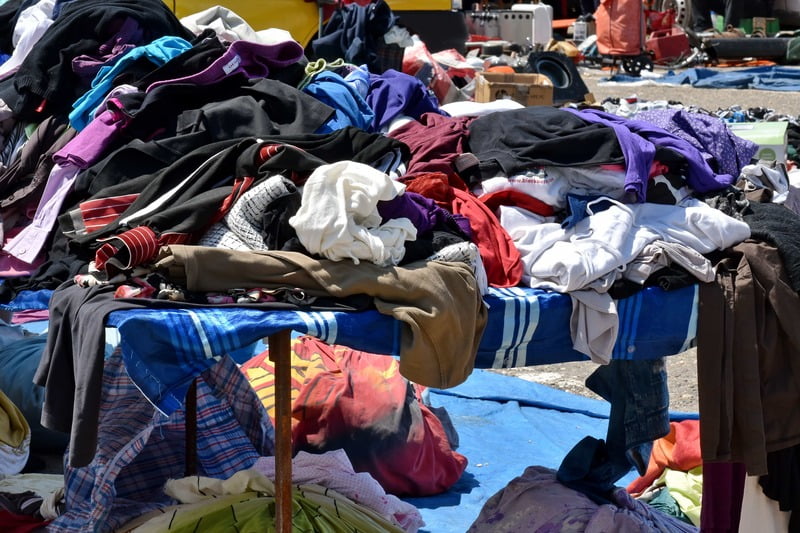In today’s age of the internet, fashion fads (trends) swing around faster than ever before. One day we’re posing for social media in oversized graphic tees, and the next we’re opting for striped cotton.
As people keep up with fashion trends, they want to buy the same popular clothes at affordable prices. This leads companies to produce fashionable items as fast as possible, before the trend is replaced by another.
The new relationship between supply and demand in the industry created the world of fast fashion. And while it makes consumers happy, it’s often not the best solution for the environment.
In this article, we’ll go over the fast fashion industry and explain how it negatively impacts the environment. The right solutions can only be formulated after the problem is fully understood.
What is Fast Fashion?
Fast fashion is a manufacturing approach that emphasizes making clothes quickly and cheaply, usually in response to the latest popular fashion trend. Fast fashion is known for being cheap, trendy, and is commonly sold in stores online.
Some larger brands associated with fast fashion include H&M, Zara, and Forever 21. However, there are also other smaller fast fashion retailers in the industry, like Fashion Nova.

However, this practice of fast and cheap clothing can translate to many unsustainable business practices.
Why You Should Care About The Fast Fashion Industry
Those who aren’t aware of the fast fashion industry may wonder why it matters when it comes to environmental awareness. After all, the most popular topics that come up regarding the environment are things like carbon footprint and ocean pollution. How does fast fashion factor into that?
Fast fashion plays into environmental pollution in many ways. The first and most concerning is the sheer size of the industry.
The world buys over 80 billion articles of clothing each year. And in the last 15 years, worldwide clothing production (and consumption) has doubled.
Part of this growth is due to the greater availability of cheap, trendy clothing in the fast fashion industry. These garments are bought, worn only a few times, and then just thrown out after their trend has died down.
Picture all that clothing being produced and shipped all over the world, the practices used to make these products, and the waste made when they are thrown into landfills after their fashion fad ends; these are all harmful to the environment.
How Does Fast Fashion Impact the Environment? (Fast Fashion’s Environmental Impact)
It’s hard to picture the waste created by billions of pieces of clothing. So, how does the fast fashion industry compare to other environmentally-hazardous industries like the oil or mining industry?
Well, the fact is that the fashion industry as a whole is the second biggest polluter in the world, topped only by the oil industry.
Here are some specific examples detailing why the environmental impact of the fast fashion industry is so huge.
Greenhouse Gases Emissions
One way the fast fashion industry pollutes the environment is through the greenhouse gases it emits. These gases come from the production and transportation of the billions of pieces of clothing bought each year.
In fact, the fashion industry contributes to about 5% of the world’s global greenhouse gas emissions. That’s equivalent to the amount of greenhouse gases emitted by the entire worldwide aviation industry, or the entire country of Russia!
Another contributor to greenhouse gas emissions in the fashion industry is the production of synthetic polymers.
Synthetic polymers are lightweight and durable, and they make clothes last longer. However, they aren’t found naturally in the world, so they have to be synthetically produced (manufactured).

During this manufacturing process, greenhouse gases like nitrous oxide are released into the atmosphere. Nitrous oxide (N2O) is a type of greenhouse gas that is 300 times more potent than carbon dioxide.
These potent greenhouse gases, being produced on a scale to create over 80 billion articles of clothing each year, is part of what makes the fast fashion industry the second biggest polluter in the world.
It Uses Non-Renewable Resources
In addition to emitting harmful greenhouse gases, the fast fashion industry also uses nonrenewable resources (fossil fuels).
For example, synthetic polymers are not renewable, and can actually be classified as a type of plastic. They can release microplastics into the water system when they’re put through the washing machine, which pollutes the environment.
Making matters worse, the mining of fossil fuels contributes to air pollution and climate change. Plus, as we all know, fossil fuels are not a sustainable resource (hence why they are non-renewable).
Depletes and Pollutes Water Resources
The fashion industry is a huge water consumer. Did you know that it takes 2700 litres of water to make a single cotton t-shirt?
Cotton, which is a common material in clothing, needs a lot of water to grow. It’s usually grown in hot regions where water scarcity is already an issue, and cotton farming just compounds the issue.
Additionally, A LOT of water is also required to dye and manufacture textiles. For example, a ton of dyed fabric can take up to 200 tons of water to produce.
To make matters worse, most clothing manufacturing is done in developing countries, where environmental laws may not be so strict. This means that many times, untreated wastewater from factories is dumped directly into rivers or lakes.

The wastewater from these factories can be extremely toxic, containing pollutants like lead, mercury and arsenic, just to name a few. Once in the water, these substances can kill aquatic life, not to mention also pollute the drinking water of local inhabitants.
Textile Waste Accumulates in Landfills
About 84% of all clothes in the USA ends up in a landfill each year (Source). Nearly all of that clothing could have been recycled, repurposed, or donated instead.
When clothes are tossed aside for a new trend, they sit in garbage dumps for decades, and possibly even centuries.
Polyester takes 200 years to decompose. Nylon is not much better either, requiring a minimum of 30-40 years. While these materials are decomposing, they’re also releasing microplastics into the soil which can pollute the nearby area.

What’s most dangerous about this post-production waste is that it’s out of sight and out of mind.
People can’t see microplastics, so it’s easy to pretend they aren’t there. The same goes for landfills, which most people don’t see often, or ever. That’s why resources must be available for people to learn about the harm of this kind of pollution.
What’s Being Done To Reduce the Environmental Effects of Fast Fashion?
While everyday consumers may not fully understand the impact fast fashion has on the environment, there are groups of people who do. They’ve come up with initiatives and programs that can be replicated for worldwide success in minimizing the damage done by fast fashion.
In New York, the idea of conservation in fast fashion is being realized by people working together with the Ellen MacArthur Foundation’s Make Fashion Circular initiative.
This initiative aims to reduce the 200 million pounds of clothing that are dumped in New York City landfills each year. It provides resources to clothing businesses so the tossed-out clothes can be recycled into new products, cutting into the pollution made by manufacturing new materials.
There’s also work being done on an international brand level. H&M created a sustainable clothing line that provides all the info consumers need to know to make an informed purchase. It publishes annual reports and a map of its suppliers, so concerned consumers can research before they buy.
Over in the U.K., the Fashion Revolution movement began in 2015 to tackle many issues in the regular and fast fashion industries. It wants to be the collaborating link between consumers and fashion businesses to safeguard the ecosystem. It makes greener production processes easier and more accessible for the clothing industry.
There are also international companies trying to help, such as Rent the Runway. The company began with the idea that clothing waste could be minimized if people weren’t stuck with the one option to buy clothes. Instead, they allow customers to rent and return clothes, so fewer products are tossed into landfills after one or two uses.
How You Can Help
After learning about how the fast fashion industry hurts the environment, it’s time to use that knowledge for good.
Here’s how you can take action and reduce your environmental impact related to the fashion industry.
1. Purchase Less Clothing
The most effective solution to solving textile pollution is to reduce your consumption (stop buying so many clothes).
Before you buy a new piece of “trendy” clothing, think about whether or not you’ll actually wear it. If you won’t wear your new clothes more than a couple of times, don’t buy it.
You can also invest in basic pieces of clothing like standard t-shirts, jeans, and sweaters. These “basics” will last you for a long time and will look normal no matter what the current trend is.
2. Buy From Environmentally-Conscious Brands
It can also be helpful to avoid brands with a track record of disregarding the environment.
Before you buy, research the company that you’re buying from to ensure that they follow sustainable business practices that help preserve and conserve our environment.
Be aware as well that some supposedly “eco-friendly” brands aren’t actually eco-friendly. Smaller online fast fashion stores may not always be trustworthy, so make sure you do proper research and verify any of their claims before buying.
3. Donate Your Unwanted Clothing
If your clothes are relatively clean, donate them instead of throwing them out. This repurposes your old clothing and makes sure that they do not end up in a landfill, where they could pile up for hundreds of years.

Many organizations will accept used clothing donations, such as The Salvation Army, Goodwill, Value Village, or other thrift stores.
Even torn fabric or partial pieces of clothing can be donated instead of being thrown out. You can research textile donation or recycling centers in your area to find a location.
4. Raise Awareness
The final way (and perhaps the most effective way) to help is to raise awareness and spread the word.
Learning about the environmental impact of the fast fashion industry is the first step toward creating change. The more people who know about the hazards of fast fashion, the more people who will take action.
Start by telling your friends about the negative effects of fast fashion, either in-person or by sharing this article. You can also consider joining an organization in your area that deals with educating the public about fast fashion.
Together as a team, we can help combat this global problem. Please spread this message and share this article with your friends by using the social media share buttons below.
This article was written in part by Jenna Tsui. Jenna is a tech journalist who co-owns The Byte Beat and frequently writes about the latest news in technology, disruptive tech, and environmental science and more. Check out her work on TBB or follow her on Twitter @jenna_tsui!



![The Environmental Impact Of Chewing Gum: Everything You Need To Know [Infographic]](https://get-green-now.com/wp-content/uploads/2017/06/The-environmental-impact-of-chewing-gum-header-768x452.jpg)

